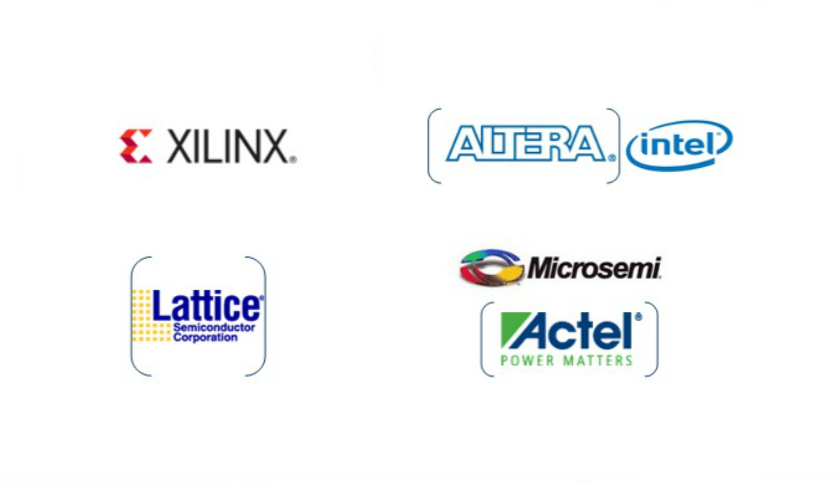Time: 2025-03-07 11:48:22View:
Field-Programmable Gate Arrays (FPGAs) are versatile hardware platforms used in a wide range of applications, from embedded systems to high-performance computing. Xilinx, Intel (formerly Altera), Lattice, and Actel (now Microsemi, part of Microchip) are major FPGA vendors, each offering unique features and targeting different market segments. Below is a detailed comparison of these FPGA families:

Product Lines:
Artix: Low-cost, low-power FPGAs for cost-sensitive applications.
Kintex: Mid-range FPGAs with a balance of performance and power.
Virtex: High-performance FPGAs for demanding applications.
Zynq: SoC FPGAs with ARM processors for embedded systems.
Versal: Adaptive compute acceleration platforms (ACAP) for AI and data center applications.
Architecture:
Based on Configurable Logic Blocks (CLBs), DSP slices, and Block RAM.
Advanced features like UltraScale+ architecture for high performance.
Tools:
Vivado Design Suite: Comprehensive design and analysis tools.
Vitis: Unified software platform for AI and software development.
Applications:
High-performance computing, AI, automotive, aerospace, and telecommunications.
Wide range of products for different market segments.
Strong ecosystem and community support.
Advanced features for AI and machine learning.
Higher cost compared to some competitors.
Steeper learning curve for beginners.
Product Lines:
Cyclone: Low-cost, low-power FPGAs for mass-market applications.
Arria: Mid-range FPGAs with transceivers for high-speed communication.
Stratix: High-performance FPGAs for data centers and high-end applications.
Agilex: Next-generation FPGAs with AI and DSP optimization.
MAX: CPLDs and low-density FPGAs for simple designs.
Architecture:
Based on Adaptive Logic Modules (ALMs), DSP blocks, and embedded memory.
Integration with Intel processors (e.g., Xeon) for heterogeneous computing.
Tools:
Quartus Prime: Design and simulation tools.
Intel oneAPI: Unified programming model for CPUs, GPUs, and FPGAs.
Applications:
Data centers, networking, automotive, and industrial automation.
Strong integration with Intel processors and ecosystem.
Competitive pricing for mid-range FPGAs.
Good support for high-speed transceivers.
Limited low-cost options compared to Xilinx.
Smaller market share in some regions.
Product Lines:
iCE40: Ultra-low-power FPGAs for IoT and mobile applications.
ECP5: Mid-range FPGAs with high performance and low power.
CrossLink: FPGAs optimized for video and sensor bridging.
MachXO: Low-density FPGAs for control and interfacing.
Nexus: Next-generation FPGAs with AI and security features.
Architecture:
Focus on low power and small form factors.
Integrated DSP blocks and memory.
Tools:
Lattice Diamond: Design and synthesis tools.
Lattice Radiant: Simplified design tools for newer FPGAs.
Applications:
IoT, consumer electronics, industrial control, and automotive.
Ultra-low power consumption.
Compact form factors.
Cost-effective for small-scale designs.
Limited performance for high-end applications.
Smaller ecosystem compared to Xilinx and Intel.
Product Lines:
ProASIC: Low-power, non-volatile FPGAs.
IGLOO: Ultra-low-power FPGAs for portable applications.
SmartFusion: SoC FPGAs with ARM Cortex-M3 processors.
PolarFire: Mid-range FPGAs with low power and high security.
Architecture:
Non-volatile, flash-based FPGAs (no external configuration memory needed).
Focus on low power and security.
Tools:
Libero SoC: Design and simulation tools.
SoftConsole: Embedded software development tools.
Applications:
Aerospace, defense, industrial, and medical.
High reliability and security features.
Non-volatile memory eliminates boot-up delays.
Low power consumption.
Limited performance for high-end applications.
Smaller ecosystem and community support.
| Feature | Xilinx | Intel (Altera) | Lattice | Actel (Microsemi) |
|---|---|---|---|---|
| Target Market | High-performance, AI, HPC | Data centers, networking | IoT, consumer electronics | Aerospace, industrial |
| Power Efficiency | Moderate to high | Moderate | Ultra-low | Ultra-low |
| Performance | High | High | Low to moderate | Low to moderate |
| Cost | High | Moderate | Low | Moderate |
| Tools | Vivado, Vitis | Quartus Prime, oneAPI | Diamond, Radiant | Libero SoC |
| Key Strengths | Versatility, AI support | Processor integration | Low power, compact | Security, reliability |
| Key Weaknesses | High cost, complexity | Limited low-cost options | Limited performance | Limited ecosystem |
1. High-Performance Applications:
Choose Xilinx Virtex or Intel Stratix.
2. Low-Power IoT Applications:
Choose Lattice iCE40 or Actel IGLOO.
3. Cost-Sensitive Designs:
Choose Lattice ECP5 or Xilinx Artix.
4. Security-Critical Applications:
Choose Actel PolarFire or Xilinx Zynq UltraScale+.
5. AI and Machine Learning:
Choose Xilinx Versal or Intel Agilex.
Each FPGA vendor offers unique strengths tailored to specific applications. Xilinx and Intel dominate the high-performance and data center markets, while Lattice excels in low-power, cost-sensitive designs. Actel (Microsemi) is ideal for applications requiring high reliability and security. The choice depends on your specific requirements, such as performance, power consumption, cost, and ecosystem support.